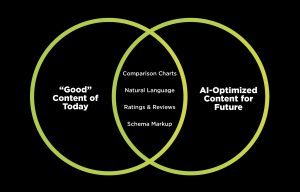AI is changing how people shop, but not why they shop.
As AI assistants and search tools become more common, brands are racing to understand what it means for marketing. But at its core, AI isn’t introducing some foreign behavior to consumers. It’s reflecting and accelerating what people already do when they buy: read reviews, compare products and prices, check availability, and rely on clear, trustworthy information.
In this article, we’ll explore the role of AI search, agent commerce, and brand agents, and why the smartest investment brands can make right now is doubling down on the fundamentals of good marketing.
What Are AI Search, Agent Commerce, and Brand Agents?
AI search platforms like Perplexity, Gemini, and ChatGPT answer customer questions directly by pulling from product data, reviews, or FAQs to summarize options in natural language.
The next evolution is what’s known as agent commerce: artificial intelligence (AI) systems that move beyond search to take action on the shopper’s behalf. These agents can automate routine purchases, such as reordering household staples based on preferences and availability, or make informed product selections by weighing factors like price, reviews, and specifications.
Brands are also exploring the use of brand agents, which are custom AI tools that live on their websites or apps. These brand agents are designed to solve real user problems, such as answering usage questions, guiding product selection, or demystifying technical specs.
AI Doesn’t Change Behavior. It Mirrors It.
Consumers already depend on certain cues to make decisions: “What do other people say about this product?” “How does it compare to others?” “Can I get it quickly?”
AI agents are learning to make those same calls. If a product has poor reviews, unclear specs, or is out of stock, the AI assistant isn’t going to recommend it (and neither would humans).
As Emily Bratton, SVP of Insights & Activation at Sales Factory explains, “AI doesn’t replace human decision-making, it just removes friction from it. If your product information isn’t clear, in stock, or supported by strong reviews, AI will select another option just like a shopper would.”
Here are the key areas worth investing in:
Product Comparisons: Side-by-side comparison charts help customers make faster, more confident decisions, and they serve the same function for AI. The more clearly you outline key differentiators, features, or use cases, the more likely your offering is to be selected or recommended by AI systems.
SEO-Optimized Content: Well-crafted, SEO-optimized content ensures that your site speaks the same language as your customers (and the platforms they use to find you). Clear headlines, relevant keywords, and natural language make your content easier for people to understand and for AI to process, rank, and summarize accurately. In the age of AI, it is also worth considering context in relation to your content. Specifically on your product detail pages (PDPs), ensure you are answering the “Who?”, “What?”, “Where?”, “Why?” and “How?” of your products.
Schema Markup: Structured data and schema markup might be invisible to the average shopper, but they’re critical behind the scenes. This code allows search engines and AI models to interpret and understand your content correctly.
Product Availability: Even the strongest product won’t get recommended if it’s out of stock, lacks key details, or has inconsistent listings. AI tools—like shoppers—can only select from what they can see and trust.
Reviews: Customers trust reviews because they reflect real experiences. AI uses them the same way. High-quality, specific, and regularly updated reviews signal credibility, relevance, and customer satisfaction. They influence not only human perception but also how AI determines whether a product should be recommended.
If you’re already investing in these principles, great. If not, now is the time to reevaluate how well you’re delivering on these core marketing fundamentals.
Utilize our AI-Optimized Marketing Fundamentals Scorecard below to better identify the strengths and gaps in your marketing from both the shopper’s and AI’s perspective.
Don’t Confuse Paid Placement with Trust
Some retailers are already monetizing their AI assistants. Amazon’s Rufus, for instance, appears to incorporate ad-based responses.
But Bratton warns this trend could erode trust if not clearly disclosed. “If you don’t know whether the answer you’re getting is truly the best, or just the best-paid, people will lose faith in the entire system,” she says.
AI Doesn’t Replace the “Why”

Whether AI agents become the norm in six months or six years, the takeaway is the same. People still want to feel informed, confident, and supported. They want products that work, that arrive on time, and that match what they read online.
AI doesn’t change that. It just gets them there faster.
The future may be AI-driven, but Bratton cautions against overcorrecting. “Don’t move all your resources toward marketing for the customer of tomorrow and lose the ones you have today,” she says.
Rather than overhauling your marketing to “optimize for AI,” focus on the overlap between what people value and what AI looks for. Because the brands that win in AI-driven search and commerce? They’re the ones already investing in the fundamentals of good marketing.
About the Author
For over 16 years, Matt has played a central role in advancing Sales Factory’s strategic and cross-functional capabilities. A graduate of North Carolina State University, he combines creative thinking with data-driven strategy to drive wins for a wide range of clients. Today, as VP of Strategic Operations & Innovation, he leads the company’s efforts to integrate and apply AI in ways that support smarter decisions and sustainable growth.
AI & Human Marketing Scorecard
Score each category from 1 (Needs Significant Improvement) to 5 (Best-in-Class). Use the guiding questions under each to assess whether your marketing is clear, complete, and actionable—for both humans and AI systems.



